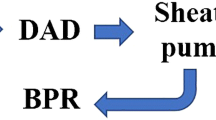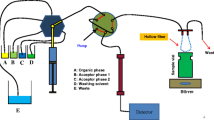Abstract
A novel and affordable analytical setup is herein reported for automatic flow-through sorptive microextraction of organic contaminants, exploiting polydimethylsiloxane (PDMS) as a front-end to gas chromatography-ion trap-tandem mass spectrometry. The analytical procedure involves a short single-strand PDMS hollow fiber integrated in a sequential injection (SI) network for automatic fluidic handling by programmable flow. The target species are in-line extracted from 10 mL of sample containing 20 % (v/v) methanol followed by elution with a metered volume of organic solvent, which is whereupon quantitatively transferred into the programmed temperature vaporization (PTV) injector of the GC. Diffusional resistance to mass transfer was overcome by effecting the overall concentration and stripping steps at a single PDMS tubing interface. The proof of concept of the novel hyphenated system was demonstrated for extraction and determination of organochlorine pesticides (OCPs), namely, heptachlor, dieldrin, endrin, endosulfan, p,p′-dichlorodiphenyldichloroethane, p,p′-dichlorodiphenyltrichloroethane, dichlorodiphenyldichloroethylene, and endrin ketone, taken as model analytes, in environmental and industrial waters. Four organic solvents with a broad spectrum of polarity were investigated as eluents in the SI-based assembly, namely, ethyl acetate, methyl tert-butyl ether, hexane, and chloroform. Chloroform was proven the most suitable solvent for expedient elution and fast evaporation in the PTV injector. Under the selected experimental variables, limits of detection (signal-to-noise ratio (S/N) = 3) within the range of 0.3–1.1 ng L−1, limits of quantification (S/N = 10) of 1.0–3.6 ng L−1, and method repeatabilities spanning from 1.7 to 4.7 % were obtained for the suite of OCPs. The hyphenated flow analyzer was harnessed to the analysis of samples of varying matrix complexity with good relative recoveries (86–112 %) in drinking water, surface water, and influent and effluent wastewaters, with quantification limits far below those endorsed by WHO and EU drinking water directives setting maximum allowed concentrations at ≤100 ng L−1 OCPs.





Similar content being viewed by others
References
Mitra S (ed) (2003) Sample preparation techniques in analytical chemistry. Wiley, Hoboken, NJ
Pawliszyn J (ed) (2012) Comprehensive sampling and sample preparation. Analytical techniques for scientists. Elsevier, Amsterdam
Pawliszyn J, Lord HL (eds) (2010) Handbook of sample preparation. Wiley, New York
Pedersen-Bjergaard S, Rasmussen KE (2008) J Chromatogr A 1184:132–142
Pena-Pereira F, Lavilla I, Bendicho C (2010) Trends Anal Chem 29:617–628
Abdel-Rehim M (2011) Anal Chim Acta 701:119–128
Miró M, Hartwell SK, Jakmunee J, Grudpan K, Hansen EH (2008) Trends Anal Chem 27:749–761
Pawliszyn J (ed) (2012) Handbook of solid-phase microextraction. Elsevier, Amsterdam
Baltussen E, Sandra P, David F, Cramers C (1999) J Microcolumn Sep 11:737–747
Lancas FM, Queiroz MEC, Grossi P, Olivares IRB (2009) J Sep Sci 32:813–824
Prieto A, Basauri O, Rodil R, Usobiaga A, Fernandez LA, Etxebarria N, Zuloaga O (2010) J Chromatogr A 1217:2642–2666
Popp P, Bauer C, Hauser B, Keil P, Wennrich L (2003) J Sep Sci 26:961–967
Montero L, Popp P, Paschke A, Pawliszyn J (2004) J Chromatogr A 1025:17–26
van Pinxteren M, Paschke A, Popp P (2010) J Chromatogr A 1217:2589–2598
Kataoka H, Ishizaki A, Nonaka Y, Saito K (2009) Anal Chim Acta 655:8–29
Kataoka H (2002) Anal Bioanal Chem 373:31–45
Cháfer-Pericás C, Herráez-Hernández R, Campíns-Falcó P (2006) J Chromatogr A 1125:159–171
Cháfer-Pericás C, Campíns-Falcó P, Prieto-Blanco MC (2008) J Chromatogr A 610:268–273
Miró M, Hansen EH (2006) Trends Anal Chem 25:267–281
Hansen EH, Miró M (2007) Trends Anal Chem 26:18–26
Pinto PCAG, Lucia M, Saraiva MFS, Lima JLFC (2011) Anal Lett 44:374–397
Economou A (2005) Trends Anal Chem 24:416–425
Lenehan CE, Barnett NW, Lewis SW (2002) Analyst 127:997–1020
Quintana JB, Miró M, Estela JM, Cerdà V (2006) Anal Chem 78:2832–2840
Quintana JB, Boonjob W, Miró M, Cerdà V (2009) Anal Chem 81:4822–4830
Wurl O, Obbard JP (2005) Atmos Environ 39:7207–7216
Korenkova E, Matisova E, Slobodnik J (2003) J Sep Sci 26:1193–1197
Concha-Graña E, Turnes-Carou MI, Muniategui-Lorenzo S, Lopez-Mahía P, Fernández-Fernández E, Prada-Rodríguez D (2001) Chromatographia 54:501–506
Magdic S, Pawliszyn JB (1996) J Chromatogr A 723:111–122
COUNCIL DIRECTIVE 98/83/EC of 3 November 1998 on the quality of water intended for human consumption (1998). Official J. Eur. Communities L 330/32-54
Guidelines for Drinking Water Quality (2008). World Health Organization, Geneva
Batlle R, Sánchez C, Nerín C (1999) Anal Chem 71:2417–2422
Valls-Cantenys C, Villaverde-de-Sáa E, Rodil R, Quintana JB, Iglesias M, Salvadó V, Cela R (2013) Anal Chim Acta 770:85–93
Montes R, Rodríguez I, Rubí E, Cela R (2007) J Chromatogr A 1143:41–47
Sgorbini B, Budziak D, Cordero C, Liberto E, Rubiolo P, Sandra P, Bicchi C (2010) J Sep Sci 33:2191–2199
Schellin M, Popp P (2007) J Chromatogr A 1152:175–183
Lee JN, Park C, Whitesides GM (2003) Anal Chem 75:6544–6554
Oh HK, Song KH, Lee KR, Rim LM (2001) Polymer 42:6305–6312
Olejniczak J, Staniewski J (2007) Anal Chim Acta 588:64–72
Seethapathy S, Gorecki T (2012) Anal Chim Acta 750:48–62
Fang ZL (1993) Flow-injection separation and preconcentration. WCH-Verlag, Weinheim
Barri T, Bergström S, Hussen A, Norberg J, Jonsson JA (2006) J Chromatogr A 1111:11–20
Basheer C, Lee HK, Obbard JP (2002) J Chromatogr A 968:191–199
Bedendo GC, Carasek E (2010) J Chromatogr A 1217:7–13
Acknowledgments
Warunya Boonjob is grateful to Conselleria d’Educació, Cultura i Universitats, Direcció General d’Universitats, Recerca i Transferència del Coneixement from the Government of the Balearic Islands for allocation of a Ph.D. stipend and travel grant for a 3-month research stay at the University of Santiago de Compostela. She also acknowledges financial support from the European Social Fund and the state budget of the Czech Republic (Project no. CZ.1.07/2.3.00/30.0061). This work was funded by the Spanish Ministry of Economy and Competitiveness (MINECO) and FEDER funds through projects CTM2010-17214 and CTQ2010-18927, and the Ramón y Cajal research program. Additional funding was provided by the Galician Government (Xunta de Galicia) through project 10MDS700006PR. The authors thank Dr. V. Cerda for the loan of analytical instrumentation.
Author information
Authors and Affiliations
Corresponding authors
Electronic supplementary material
Below is the link to the electronic supplementary material.
ESM 1
(PDF 125 kb)
Rights and permissions
About this article
Cite this article
Boonjob, W., Quintana, J.B., Rodil, R. et al. In-line sequential injection-based hollow-fiber sorptive microextraction as a front-end to gas chromatography–mass spectrometry: a novel fully automatic sample processing technique for residue analysis. Anal Bioanal Chem 405, 8653–8662 (2013). https://doi.org/10.1007/s00216-013-7253-y
Received:
Revised:
Accepted:
Published:
Issue Date:
DOI: https://doi.org/10.1007/s00216-013-7253-y




